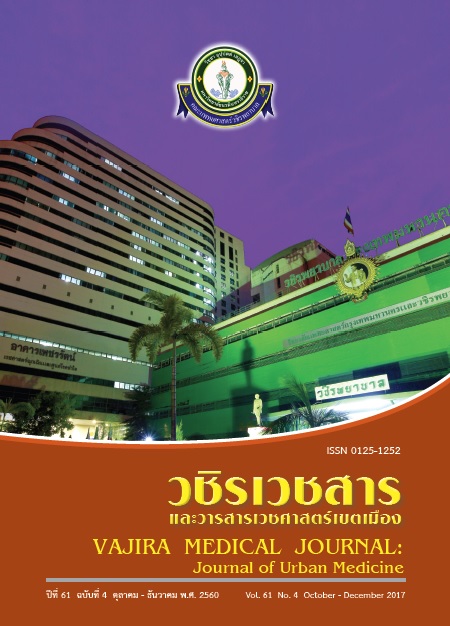Test Analysis with Classical Test Theory (CTT): Finding Item Difficulty and Item Discrimination using SPSS Program
Main Article Content
Abstract
Test analysis is important for the test quality, in particular in assessing the difficulty of the test and discrimination of all items. The results of analysis indicate the quality of the test or whether it should be modified. Both values lead to improving the test and course quality. Accessibility to a program of examination analysis may be a limitation. The SPSS statistical program is suitable for use in this analysis for those who have never analyzed or who have started to do it by themselves. As no application is able to analyze the examination test directly, using SPSS is a good way for easy and fast analysis.
Downloads
Download data is not yet available.
Article Details
How to Cite
Muangkhoua, S. (2017). Test Analysis with Classical Test Theory (CTT): Finding Item Difficulty and Item Discrimination using SPSS Program. Vajira Medical Journal : Journal of Urban Medicine, 61(4), 291–318. retrieved from https://he02.tci-thaijo.org/index.php/VMED/article/view/196119
Section
Review Articles
References
1. Livingston SA. Item analysis. In: Downing SM, Haladyna TM, eds. Handbook of test development. Mahwah, NJ: Lawrence Erlbaum Associates; 2006. p.421-41.
2. Brown W, Thomson GH. The essentials of mental measurement, 2nd ed. Cambridge, England: University Press; 1921.
3. Hambleton RK, Swaminathan H. Item Response Theory: Principles and Application. Boston: Kluwer-Nyjhoff; 1985.
4. Lord FM, Novick MR. Statistical theories of mental test scores. Reading, MA: Addison Wesley; 1968.
5. Siri A, Freddano M. The use of item analysis for the improvement of objective examinations. Procedia Soc Behav Sci. 2011; 29:188-97.
6. Yen WM, Fitzpatrick AR. Item response theory. In: Brennan RL, ed. Educational Measurement, 4th ed. Westport, CT: Praeger Publishers 2006;111-53.
7. วัฒนา สุนทรธัย. การวิเคราะห์ข้อสอบด้วยโปรแกรม สำเร็จรูป. วารสารศึกษาศาสตร์. 2554; 22(3): 32-46.
8. สุวิมล ติรกานันท์. การสร้างเครื่องมือวัดตัวแปรในการวิจัย ทางสังคมศาสตร์: แนวทางสู่การปฏิบัติ. กรุงเทพฯ: โรงพิมพ์ แห่งจุฬาลงกรณ์มหาวิทยาลัย; 2550.
9. Mitra NK, Nagaraja HS, Ponnudurai G, Judson JP. The levels of difficulty and discrimination indices in type a multiple-choice questions of pre-clinical semester 1 multidisciplinary summative tests. IeJSME. 2009; 3(1): 2-7.
10. DeVellis RF. Classical test theory. Med Care. 2006; 11(30): s50-9.
11. Ebel RL, Frisbie DA. Essentials of Educational Measurement. 5th ed. Englewood Cliffs, NJ: Prentice-Hall, Inc; 1991.
12. Haladyna TM. Writing test items to evaluate higher order thinking. Boston, MA: Allyn and Bacon; 1997.
13. บุญใจ ศรีสถิตย์นรากูร. การพัฒนาและตรวจสอบคุณภาพ เครื่องมือวิจัย: คุณสมบัติการวัดเชิงจิตวิทยา. กรุงเทพฯ: โรงพิมพ์แห่งจุฬาลงกรณ์มหาวิทยาลัย. 2555.
14. Quaigrain K, Arhin KA. Using reliability and item analysis to evaluate a teacher-developed test in educational measurement and evaluation. Cogent Edu. 2017;4: 1-11.
15. Kelly TL. The selection of upper and lower groups for the validation of test items. J Edu Psychol. 1939;30: 17-24.
2. Brown W, Thomson GH. The essentials of mental measurement, 2nd ed. Cambridge, England: University Press; 1921.
3. Hambleton RK, Swaminathan H. Item Response Theory: Principles and Application. Boston: Kluwer-Nyjhoff; 1985.
4. Lord FM, Novick MR. Statistical theories of mental test scores. Reading, MA: Addison Wesley; 1968.
5. Siri A, Freddano M. The use of item analysis for the improvement of objective examinations. Procedia Soc Behav Sci. 2011; 29:188-97.
6. Yen WM, Fitzpatrick AR. Item response theory. In: Brennan RL, ed. Educational Measurement, 4th ed. Westport, CT: Praeger Publishers 2006;111-53.
7. วัฒนา สุนทรธัย. การวิเคราะห์ข้อสอบด้วยโปรแกรม สำเร็จรูป. วารสารศึกษาศาสตร์. 2554; 22(3): 32-46.
8. สุวิมล ติรกานันท์. การสร้างเครื่องมือวัดตัวแปรในการวิจัย ทางสังคมศาสตร์: แนวทางสู่การปฏิบัติ. กรุงเทพฯ: โรงพิมพ์ แห่งจุฬาลงกรณ์มหาวิทยาลัย; 2550.
9. Mitra NK, Nagaraja HS, Ponnudurai G, Judson JP. The levels of difficulty and discrimination indices in type a multiple-choice questions of pre-clinical semester 1 multidisciplinary summative tests. IeJSME. 2009; 3(1): 2-7.
10. DeVellis RF. Classical test theory. Med Care. 2006; 11(30): s50-9.
11. Ebel RL, Frisbie DA. Essentials of Educational Measurement. 5th ed. Englewood Cliffs, NJ: Prentice-Hall, Inc; 1991.
12. Haladyna TM. Writing test items to evaluate higher order thinking. Boston, MA: Allyn and Bacon; 1997.
13. บุญใจ ศรีสถิตย์นรากูร. การพัฒนาและตรวจสอบคุณภาพ เครื่องมือวิจัย: คุณสมบัติการวัดเชิงจิตวิทยา. กรุงเทพฯ: โรงพิมพ์แห่งจุฬาลงกรณ์มหาวิทยาลัย. 2555.
14. Quaigrain K, Arhin KA. Using reliability and item analysis to evaluate a teacher-developed test in educational measurement and evaluation. Cogent Edu. 2017;4: 1-11.
15. Kelly TL. The selection of upper and lower groups for the validation of test items. J Edu Psychol. 1939;30: 17-24.


